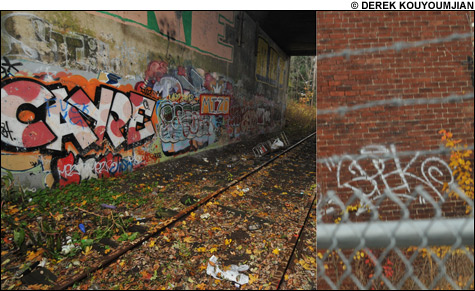Since the SPEK bust, King, Kelley, and O’Loughlin have connected with police in Peabody, Marblehead, Cambridge, Chelsea, Somerville, Melrose, Malden, Winthrop, Revere, and Lynn. Representatives from each precinct meet as a task force once a month to share tips, concerns, and snapshots of tags that surface in their jurisdictions. Much like the way graf artists long evaded prosecution by teaming with associates in other towns and cities, authorities have found success in unity. They don’t have a common digital database yet — and are still relying on books filled with photographs — but police claim the intelligence share has already proven adequate.
“The taggers give us too much credit — it’s not like we have a whole office dedicated to this,” says Kelley. “They make it too easy for us to get them. When you see the success that we’ve had, that shows how easy it is. Some people say the police should be spending their time on other things. That’s crap — I do spend my time on other things. It’s just that we have a community that complains about graffiti, and now we have a fairly good mechanism in place in terms of communication.”
Then again, communication is only one tactic that Kelley and his task force use to seek and destroy writers. He admits to having an undercover MySpace account for the past five years, and says that vandals have more than once naively e-mailed him their real names and planned-bombing locations. Kelley also posts identities and addresses of writers on Web sites, such as bombingscience.com, possibly exposing them to both civilians who seek vigilante justice and rival crews.
“I’m surprised that they would complain about us doing that,” says Kelley. “They should be more worried about the constant contact that they have with people on MySpace who they don’t know.” One writer, who was outed online and who notes that beefs between crews sometimes lead to deadly violence, counters: “I can’t believe they admit to doing that shit. I bet they won’t admit to it when someone shows up at one of our families’ houses and kills someone.”

GRAFFITI’S MOST WANTED: Once tagger royalty, Tyson Andree Wells (a/k/a CAYPE) and Adam Brandt (a/k/a SPEK) are now held up by Boston-area law enforcement as two of the biggest arrests to date in the ramped-up battle against vandalism. |
Caype crusaders
In addition to police, graffiti artists face the wrath of various community groups that pressure courts to seek harsh sentences. In a sense, police are merely responding to vandalism complaints, which Kelley says are the third most frequent, after calls concerning house and car break-ins. While individual business and homeowners contact police from time to time, neighborhood watchdogs have taken crime reporting to more sophisticated levels.
Around Boston, groups have formed from Jamaica Plain and Mission Hill through the Fenway, Brighton, and beyond. Kelley says it is important for such efforts to proliferate in every corner of the city, or else writers spread into areas that lack civilian patrols, as he notes happened in the late ’90s around Allston.
By far, the most aggressive of the anti-graf groups is the Neighborhood Association of Back Bay (NABB). The organization has raged against illicit street décor for nearly 15 years, and, as did O’Loughlin, played a significant role in pushing for the aforementioned 1995 tagging statute.